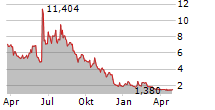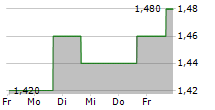
ZÜRICH, SWITZERLAND / ACCESSWIRE / May 28, 2024 / NLS Pharmaceutics Ltd. (NASDAQ:NLSP)(NASDAQ:NLSPW) ("NLS" or the "Company"), a Swiss clinical-stage biopharmaceutical company dedicated to pioneering therapies for rare and complex central nervous system disorders, today announced promising results from its preclinical study KO-874 at the American Society of Clinical Psychopharmacology (ASCP) in Miami. This study evaluated the neuroprotective effects of mazindol on nocturnal activity in a rat model with narcoleptic-like symptoms induced by orexin-B-saporin (OX-B-SAP) lesions in the lateral hypothalamus (LH).
"These data underscore our continued commitment to advancing our pipeline which has the potential to change the treatment paradigm for patients impacted by sleep and wakefulness disorders, and highlights the promise of mazindol to reduce the suffering of patients with narcolepsy," said Eric Konofal, MD,PhD, Chief Scientific Officer of NLS Pharmaceutics.
Poster Presentation: "Neuroprotective Effect of Mazindol on Nocturnal Activity in an Orexin-B-Saporin-Induced Narcoleptic-Like Model in Sprague-Dawley Rats
Presenter: Dr. Eric Konofal, Chief Scientific Officer, NLS Pharmaceutics
Date and Time: Thursday, May 30, 2024 12:30-2:15pm ET
Key Findings
Neuroprotective Efficacy: Mazindol, administered at a dose of 3 mg/kg, significantly mitigated the reduction in circadian activity typically induced by OX-B-SAP lesions. By Day 21, mazindol not only restored activity levels to normal but exceeded those of the sham group during the dark phase, demonstrating a robust protective effect against orexin cell loss.
Dose-Dependent Response: The study highlighted the importance of dosage, as lower doses of mazindol (1 mg/kg) did not show therapeutic benefits and might have aggravated the decrease in activity between days 5 and 8 post-lesion. Conversely, the higher dose (3 mg/kg) significantly increased circadian activity, indicating its potential utility in treating disorders like narcolepsy, where orexin system disruption leads to decreased wakefulness.
Orexinergic Mechanisms: The results suggest that mazindol might exert its effects through direct or indirect modulation of orexin receptors or pathways influenced by the orexin system. The lack of significant modification in the number of orexin neurons by mazindol treatment underscores the complex interaction between mazindol and orexin signaling.
Study Details
The study utilized Sprague-Dawley rats with OX-B-SAP lesions in the LH to mimic narcoleptic symptoms. The primary objectives were to assess the extent of circadian activity disruption and evaluate the neuroprotective impact of mazindol. Key parameters included:
Circadian Activity Monitoring: Activity was recorded continuously, with significant findings showing that mazindol-treated rats exhibited higher activity levels during the dark phase compared to vehicle-treated rats.
Histological Analysis: The extent of orexin neuron loss was evaluated post-mortem, confirming the targeted lesioning by OX-B-SAP and the neuroprotective effect of mazindol.
Conclusion
The positive outcomes from study KO-874 support further clinical development of mazindol as a potential therapeutic for narcolepsy and other disorders involving orexin system disruption. NLS Pharmaceutics remains committed to advancing this promising compound through clinical trials to address significant unmet needs in sleep and wakefulness disorders.
A copy of this poster presentation can be found on the News and Conferences page of the Company's website www.nlspharma.com. The abstract from ASCP can be found here.
About NLS Pharmaceutics Ltd.
NLS Pharmaceutics Ltd. is a Swiss clinical-stage biopharmaceutical company led by an experienced management team with a track record of developing and repurposing product candidates to treat rare and complex central nervous system disorders. The Company's lead product candidate, Quilience®, is a proprietary extended-release formulation of Mazindol (Mazindol ER) and is being developed for the treatment of narcolepsy, and potentially other sleep-wake disorders such as idiopathic hypersomnia (IH), for which NLS recently obtained Orphan Disease Designation (ODD) from the European Medicines Agency (EMA). Mazindol is a triple monoamine reuptake inhibitor and partial Orexin-2 Receptor agonist, which was used for many years to treat patients diagnosed with narcolepsy in compassionate use programs. A Phase 2a multi-center U.S. clinical trial evaluating Quilience® in adult subjects suffering from narcolepsy met its primary endpoint with high statistical significance and demonstrated a favorable safety and tolerability profile. NLS also successfully completed a Phase 2 study in the U.S. evaluating Nolazol® (Mazindol Controlled-Release) in adult subjects suffering from ADHD. The study met all primary and secondary endpoints and Nolazol® was well-tolerated. Quilience® has received Orphan Drug Designations both in the U.S. and in Europe for the treatment of narcolepsy. Up to 1/3 of narcoleptic patients are also diagnosed with ADHD.
Safe Harbor Statement
This press release contains expressed or implied forward-looking statements pursuant to U.S. Federal securities laws. For example, NLS is using forward-looking statements when it discusses the potential of its pipeline to change the treatment paradigm for patients impacted by sleep and wakefulness disorders, as well as the potential advancement of mazindol to through clinical trials and ultimately to address significant unmet needs in sleep and wakefulness disorders. These forward-looking statements and their implications are based on the current expectations of the management of NLS only and are subject to a number of factors and uncertainties that could cause actual results to differ materially from those described in the forward-looking statements. The following factors, among others, could cause actual results to differ materially from those described in the forward-looking statements: changes in technology and market requirements; NLS may encounter delays or obstacles in launching and/or successfully completing its clinical trials; NLS' products may not be approved by regulatory agencies, NLS' technology may not be validated as it progresses further and its methods may not be accepted by the scientific community; NLS may be unable to retain or attract key employees whose knowledge is essential to the development of its products; unforeseen scientific difficulties may develop with NLS' process; NLS' products may wind up being more expensive than it anticipates; results in the laboratory may not translate to equally good results in real clinical settings; results of preclinical studies may not correlate with the results of human clinical trials; NLS' patents may not be sufficient; NLS' products may harm recipients; changes in legislation may adversely impact NLS; inability to timely develop and introduce new technologies, products and applications; loss of market share and pressure on pricing resulting from competition, which could cause the actual results or performance of NLS to differ materially from those contemplated in such forward-looking statements. Except as otherwise required by law, NLS undertakes no obligation to publicly release any revisions to these forward-looking statements to reflect events or circumstances after the date hereof or to reflect the occurrence of unanticipated events. More detailed information about the risks and uncertainties affecting NLS is contained under the heading "Risk Factors" in NLS' annual report on Form 20-F for the year ended December 31, 2023 filed with the Securities and Exchange Commission ("SEC"), which is available on the SEC's website, www.sec.gov, and in subsequent filings made by NLS with the SEC.
Company Contacts:
Eric Konofal, MD, PhD
Chief Scientific Officer
NLS Pharmaceutics
ek@nls-pharma.com
Investor Relations
InvestorRelations@nls-pharma.com
www.nlspharmaceutics.com
SOURCE: NLS Pharmaceutics AG
View the original press release on accesswire.com


